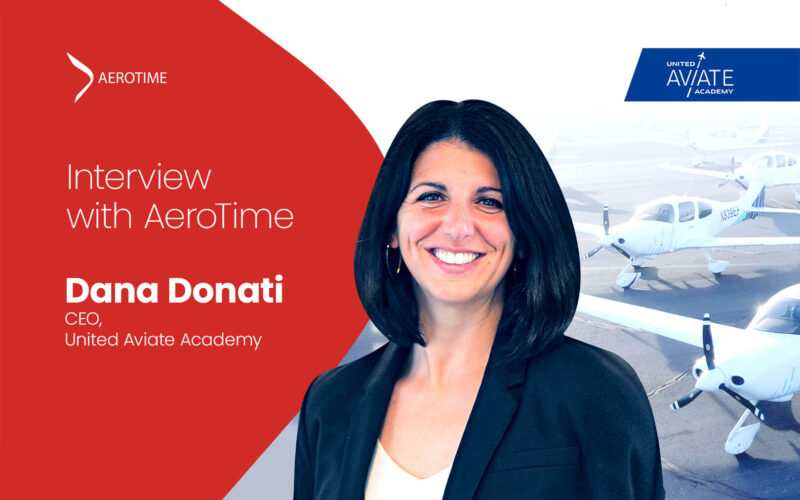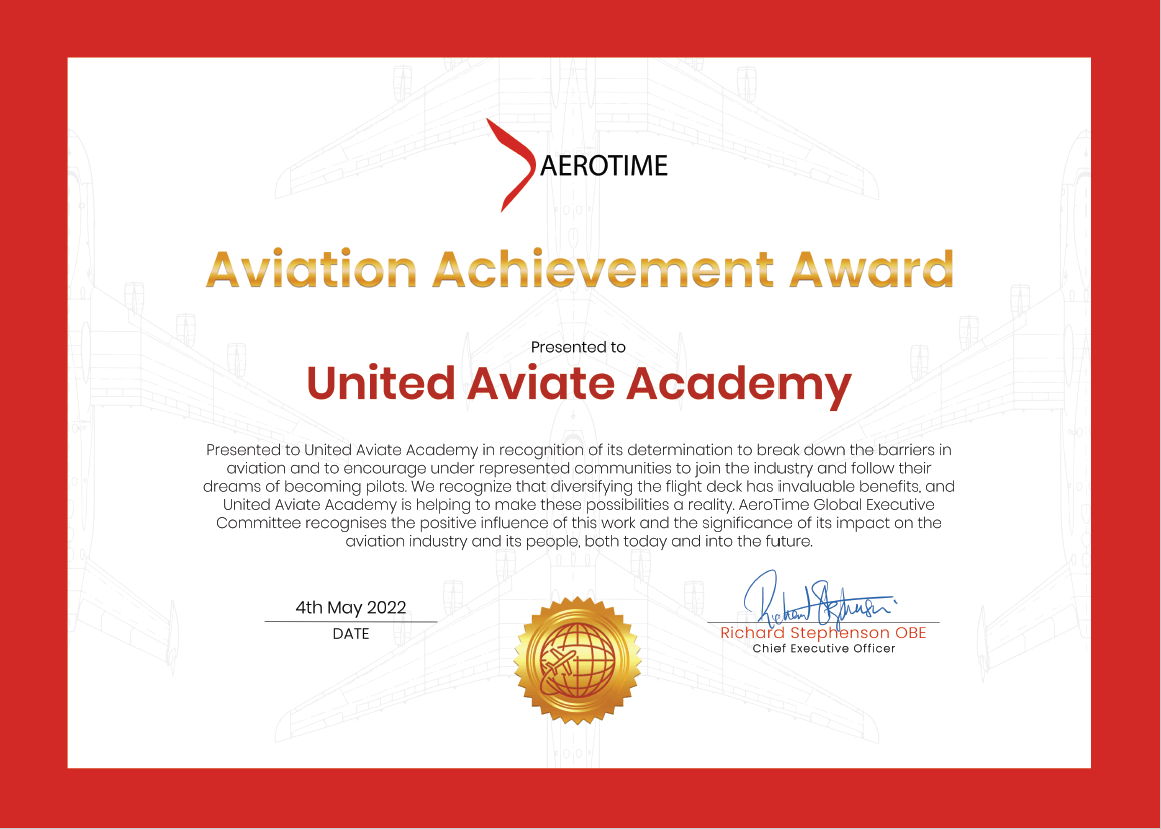In an exclusive interview, AeroTime CEO Richard Stephenson spoke with the CEO of the United Aviate Academy, Dana Donati. They discussed how her exciting career path in the aviation industry led to her running the academy. In light of the school’s work to train and diversify our future pilots, Donati was presented with the AeroTime Aviation Achievement Award on behalf of the United Aviate Academy.
Dana Donati is an aviation professional through and through.
She became a pilot at the age of 22. After a few years working as a flight instructor, Dana landed her first airline role as a first officer flying a Dash-8 across the East Coast of the United States. She went on to become a Captain, flying an Embraer E170, E175, and Dash Q-400. Later, Dana spent a few years as an assistant chief pilot before returning to college to become the Dean of Aviation.
Dana’s love for aviation began at 15 years old when she was offered an opportunity to sit up in the cockpit for takeoff and landing during a military flight from Pittsburgh, Pennsylvania to Germany.
“I think everybody thought I was going to head back after takeoff,” Dana remembers. “I actually set up there the entire flight and was fascinated by what the pilots and the navigator were doing. I just had so many questions for them. Upon landing, I asked all three of them, ‘where did you go to college?’ All three said they went to the Community College of Beaver County and Robert Morris University. So, being from the Pittsburgh area, those are the colleges that I went to get into [this] career.”
Now, Dana is the chief executive officer at the United Aviate Academy, working with educators and guidance counselors to help students, including those from underrepresented communities, to discover pathways into aviation.
Dana is also heavily focused on giving back and helping people to experience the same kind of exciting aviation career she has enjoyed.
She says: “I did not come from a family of aviators. So, I truly had to navigate this career on my own. I had very close friends that assisted along the way, I encountered a lot of mentors that helped me as well.
“But it wasn’t until many years into my career, that I became very passionate about helping the next generation of pilots coming through the system.”
Bringing diversity to an industry that is behind the times
In aviation, the number of women and people of color who are in roles such as piloting, air traffic control, and engineering, suggests that the industry still has some way to go before it can claim to be diverse and inclusive.
According to the International Society of Women Airline Pilots (ISA+21), in 2021, just 6% of the world’s airline pilots were female. If we take aerospace engineering as an example, we see that just 12.5% of all aerospace engineers in 2021 were women, while 82.7% were men, according to a recent report titled ‘Aerospace Engineer and Demographic Statistics 2022’ published by career research company, Zippia.
In addition to the gender imbalance, the most common ethnicity among aerospace engineers was reported to be white, accounting for 73.3% of all aerospace engineers.
“We are the industry that is behind our times. I mean, when you look at manufacturing, and construction, and medical, they all have taken on this charge several years ago. So, I really do hope that we can get to a point where we’re not talking about the female pilot, that we’re talking about a pilot who just happens to be a female because it’s normal and it’s normal to see females and minorities walking through the airports wearing that uniform.”
In order to bring more diversity to the industry, Dana believes that we need more outreach, professional development and mentorship programs.
“We can’t expect students to enter this career if they don’t know what to ask, who to go to or where to go,” she says.
Dana is keen to encourage aviation professionals and organizations to make aviation a more engaging industry so that students can explore different roles within the sector.
“There are so many careers in aviation. It’s not just being a pilot,” Dana adds. “If it wasn’t for that one experience when I was 15 years old, I don’t know exactly where I would be. So, I really encourage organizations, especially in aviation, to give our youth the experiences they need so they can see if this is a career that they’re interested in.”
Ensuring accessibility and reaching out to all communities
United Aviate Academy is looking for students who are highly motivated, determined, possess good judgment, and are willing to learn technical skills. To achieve this, the school is making sure to reach out to as many communities as possible.
“This career should not be a career that can only tap into those that can afford it,” Dana says. “We need to find skill holes everywhere because there’s people that look at the cost of training and are pushed away just because they can’t afford it.
“So, how can we partner with the right communities, partner with the right entities to ensure that everybody who has the skills and the practical skills to enter this career has the opportunity.”
This is not an easy feat to accomplish alone. Therefore, the academy has partnered with a number of organizations, helping to change those numbers and create a more diverse environment for pilots.
These organizations include JP Morgan Chase, Sisters of the Skies, Women in Aviation, Latino Pilots Association, Organization of Black Aerospace Professionals, Professional Asian Pilots Association, and the National Gay Pilots Association.
“It’s through those partnerships and those outreach programs that scholarships are being awarded that different communities are being tapped into. So, we truly are proud of our partnerships,” Dana says.
Advice for the next generation of pilots
The aviation industry is facing a huge pilot shortage right now, which is a pressing problem globally. But what can be done to find the 10,000 pilots who will be required to support the industry over the next decade?
“You have to start younger,” Dana says. “We have to get into those high schools, those middle schools, and even do some grassroot efforts with elementary schools. Again, it comes down to those experiences, and those exposures that we can do at a very early age to ensure that we’re tapping into the right talent for this career.”
For young women and girls who are thinking about a career in aviation, Dana has one piece of important advice – go to the airport.
“There are so many opportunities for discovery flights at airports across the country,” she says. “So, you can spend an hour in the air for a pretty low cost. Reach out to those schools, talk to the pilots, get your high school involved with the local airport. I know a lot of airports do tower tours of the air traffic control towers. You can tour a hangar to see if maybe being an aircraft mechanic is an opportunity for you.”
AeroTime Aviation Achievement Award Recipients
The AeroTime Global Executive Committee recognizes United Aviate Academy’s positive influence, and the significance of its efforts on both the aviation industry and its people.
Presenting Dana with the award, Richard Stephenson said that AeroTime Aviation Achievement award is “Presented to United Aviate Academy in recognition of its determination to break down the barriers in aviation and to encourage underrepresented communities to join the industry and follow their dreams of becoming pilots. We recognize that diversifying the flight deck has invaluable benefits, and United Aviate Academy is helping to make these possibilities a reality.”


